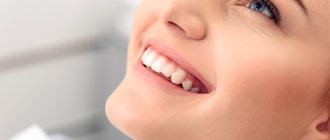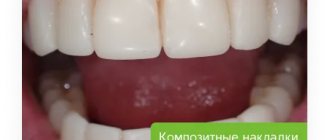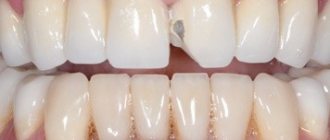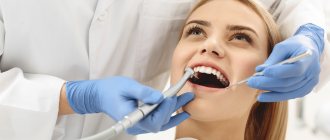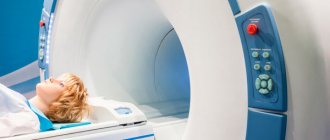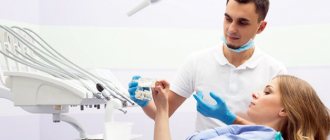What is Air Flow cleaning and how is it done?
Air Flow teeth cleaning is an effective dental procedure that allows you to remove bacterial and pigmented plaque, soft and hard deposits from the surface of your teeth. To achieve the desired result, a special device “Air Flow” (made in Sweden) is used, which gave the name to the procedure.
The Air Flow device creates a directed flow of air, water and fine abrasive particles. Applied to the surface of the teeth under high pressure, it delicately removes (cleanses) visible plaque and deposits from the surface of the teeth. As a rule, sodium bicarbonate is used as an abrasive - ordinary soda.
Teeth cleaning using the Air Flow system is carried out only in a dental setting and includes several stages.
- Treating lips with Vaseline.
- Position of the saliva ejector in the patient's mouth.
- The placement of a device in the mouth to collect excess flow of water, air and fine particles.
- Treatment of each tooth with a high-pressure stream at an angle of 30 - 600.
- Grinding of teeth using leveling paste.
- Treatment of teeth with a special fluoride-based gel to strengthen tooth enamel and reduce its sensitivity.
During treatment with a directed flow, special attention is paid to hard-to-reach places - interdental spaces, periodontal pockets. Unable to be cleaned during daily oral hygiene, they contain large amounts of plaque and deposits. But thanks to the penetrating power of Air Flow, they can be removed without much difficulty.
The total duration of the procedure is from 40 minutes to 1 hour, which depends on the condition of the teeth and the complexity of the problem.
How is the procedure done?
The procedure lasts about 30 minutes. During this time, the doctor prepares the patient and the equipment - gives the person protective glasses and a cap, installs special devices for isolating the gums and mucous membranes, connects a dental vacuum cleaner and saliva ejector.
The doctor treats each tooth, making circular movements near the enamel, but without touching it. In this case, the doctor can regulate the strength of the flow of compressed air and abrasive particles, and the angle of inclination of the hardware tip in relation to the surface being treated. The jet is directed at the tooth, but not at the gum tissue. Stone particles, as well as residual cleaning solution, are removed using special dental equipment.
The last stage consists of polishing the teeth with a special brush with an abrasive paste, which makes the surface perfectly even and smooth. Additionally, a protective varnish with fluorine is applied to strengthen the enamel.
Usually the patient does not experience any unpleasant or painful sensations, but if any discomfort occurs, the dentist may apply local anesthesia.
Cleaning with braces
Quite often, treatment with braces makes it difficult to thoroughly clean teeth. As a result, plaque and deposits can accumulate around orthodontic structures, for which the Air Flow system is ideal for removing. A targeted fine stream will gently clean the surface of the teeth and help maintain the necessary oral hygiene during orthodontic treatment.
The appearance of bacterial and pigment plaque, soft and dense deposits inevitably leads to the development of caries. Its progression provokes the appearance of such serious dental diseases as periodontitis and pulpitis - in this case, tooth loss is inevitable. Professional teeth cleaning using the modern Air Flow device helps stop the development of possible complications.
Indications for the procedure
Professional oral hygiene using a sandblasting machine is recommended in the following cases:
- Visible darkening of the enamel color.
- The presence of pigment plaque and deposits on the surface of the teeth.
- Smoker's plaque
- Accumulation of plaque and deposits in the interdental space and periodontal pockets.
- The presence of braces, bridges and other dental structures that make hygienic cleaning of the oral cavity difficult.
- Upcoming procedure for dentures or teeth whitening.
Important to remember! The use of Air Flow is advisable for aesthetic, therapeutic and preventive purposes. Removing dental plaque will help restore your teeth to an attractive appearance and prevent the development of caries and serious dental diseases.
Contraindications
Removing plaque and deposits using the Air Flow device is considered a minimally invasive procedure that is well tolerated by the human body and does not harm its health. And only in rare cases is the procedure impossible. The following conditions and pathologies are such contraindications.
- The patient has not reached 15 years of age.
- Following a salt-free diet.
- Chronic respiratory diseases.
- Increased sensitivity of tooth enamel.
- Individual allergic reactions to the manipulations performed or the composition of the abrasive powder for cleaning.
- Pregnancy period.
Important to remember! Professional cleaning of the oral cavity with Air Flow is carried out only after prior consultation with a dentist. In case of chronic diseases, consultation with your doctor is necessary.
Air flow technology - description of the procedure
An enamel cleansing session usually takes no more than half an hour. The top plaque formed under the influence of food and drinks, especially those containing coloring pigments, is removed. It should be noted right away that the technique does not refer to a method of artificially lightening enamel, which means that the procedure allows you to achieve natural whiteness of teeth. If your natural enamel shade is slightly yellowish or grayish, you should not count on a snow-white Hollywood smile. To make the natural color flawlessly white, you will have to undergo a professional lightening procedure or resort to the help of veneers.
Preparatory activities
First, you will have to undergo a standard oral examination by a dentist. The specialist will assess the extent of the problem and offer the best option for removing supra- and subgingival deposits. If you are prone to allergic reactions or suffer from intolerance to the components of the products used, be sure to inform your doctor. It is better for women not to use cosmetics before the session, as washing may be required after the procedure.
Before the procedure, you need to undergo an examination by a dentist
Description of the enamel cleansing session
The process of cleaning enamel using the Air Flow device involves several stages. Below is a brief step-by-step description of the procedure:
- first, the doctor covers the patient’s lips with Vaseline so that they do not dry out,
- after this, a saliva ejector is placed in the mouth, which helps to avoid excessive salivation during the procedure,
- then a special hat and glasses are put on to protect the face and hair from small particles of abrasive powder for brushing teeth,
- the doctor carefully treats each tooth, making sure that the jet does not fall on soft tissues and dentin in the presence of caries and erosions,
- the treated enamel is coated with a special fluorine-containing composition, which ensures that the achieved effect is consolidated.
The photo shows the procedure for brushing teeth with the Air Flow system.
The dentist independently controls the force of the jet pressure, thus optimizing the intensity of its effect on soft and hard deposits. As a result, effective, but at the same time gentle removal of plaque and food debris occurs, which serves as the best prevention of caries.
Recovery stage
Immediately after the session, the teeth lose their thin surface film, so for some time the enamel may react sharply to mechanical stress and sudden temperature changes - a completely natural phenomenon that does not need to be alarmed. To preserve the achieved effect, experts recommend not smoking, drinking caffeine-containing drinks, black tea and colored soda for 2-3 hours. It is also worth at least temporarily limiting the consumption of fruits and berries that contain intense coloring pigments.
How is Air Flow different from ultrasonic cleaning?
The effectiveness of the Air Flow technique is based on the abrasive properties of a fine flow that cleans the surface of the teeth. While the success of ultrasonic teeth cleaning is built on the ability of ultrasonic waves to destroy plaque, deposits and tartar due to a certain vibration frequency. Both methods are classified as mechanical teeth cleaning and are recommended for maintaining oral health.
In order to understand the difference between Air Flow and ultrasonic cleaning, let's look at the main advantages and disadvantages of these methods.
Benefits of Air Flow
- Minimally invasive.
- Removal of pigment, bacterial plaque and soft deposits.
- Ability to clean hard-to-reach places.
- Effective cleaning of teeth with braces, bridges and implants.
Flaws
- The method is not recommended for hypersensitive teeth.
- Air Flow will not remove tartar.
Benefits of ultrasonic cleaning
- Minimally invasive.
- Removal of pigment and bacterial plaque.
- Removal of soft and hard deposits.
- Tartar removal.
- Ability to clean hard-to-reach places.
Flaws
- The impossibility of using ultrasound in the presence of braces, implants and other dental structures.
Thus, Air Flow can be compared to “thorough cleaning”, and the use of ultrasound to “spring cleaning” in the oral cavity. Both methods differ not only in the method of exposure, but also in the depth of cleaning.
20% discount on prof. hygiene
Moscow
What are the restrictions?
The technique is absolutely safe for the health of teeth and the oral cavity in general, however, it still has certain contraindications for use. Thus, Air-Flow hardware cleaning is not prescribed in the following situations:
- periodontal disease - there is a risk of bleeding, as well as gum inflammation and swelling,
- impressive volumes of dental plaque – unfortunately, the device cannot cope with deep and long-hardened dental plaque. Here it is better to resort to ultrasonic enamel cleaning techniques,
Ultrasound removal of tartar - pathological conditions of the respiratory system,
- allergy to citrus.
Also, this procedure does not apply to patients who, for health reasons, must adhere to a salt-free diet. Such cleaning is allowed for pregnant women and nursing mothers, but it should be carried out with extreme caution.
What's better?
Ideally, it is necessary to combine ultrasonic cleaning with the Air Flow procedure. The first will destroy hard deposits and tartar, which is especially important for hard-to-reach places, and the finely dispersed flow will delicately remove soft deposits and plaque.
Which is better is a difficult question. It all depends on the complexity of the problem, the individual characteristics of the enamel and the presence of contraindications. Therefore, an accurate answer can only be given after diagnosing the general condition of the oral cavity.
Note! The Air Flow procedure and ultrasonic cleaning are not teeth whitening. During these procedures, only slight whitening of the enamel is possible, by 1–2 tones, which is achieved by removing visible pigment plaque.
Advantages and disadvantages
Like every dental procedure, Air Flow cleaning has both pros and cons, and every patient should be aware of them and take them into account.
The undoubted advantages of the method include the following points:
- cleaning teeth and subgingival pockets;
- along with the removal of deposits, pathogenic bacteria are destroyed, which is an excellent prevention of dental problems;
- removes bad breath;
- the procedure is painless, and in case of increased sensitivity, the dentist offers local anesthesia;
- nothing chemical, the treatment is carried out with a natural substance - soda, to which allergic reactions practically do not occur;
- the manipulation is carried out in one visit to the doctor and takes no more than 30 minutes;
- tooth enamel without layers and stone acquires its natural whiteness;
- small, compared to other methods, the cost of the procedure.
Despite all the obvious advantages of Air Flow, the disadvantages of the method include the following points:
- if there are old tartar, the air flow may not cope with the task, then other cleaning methods should be used;
- those expecting a snow-white smile may be disappointed, since removing the stone lightens the enamel by no more than 1-2 tones;
- a soda solution upon contact with the mucous membrane can cause a burning sensation, discomfort in the mouth, and if the composition is swallowed, an upset stomach;
- cleaning can be done no more than 2 times a year;
- There are medical contraindications to its use.
Air Flow during pregnancy
Pregnancy is a relative contraindication to the procedure. The problem is that during this period, calcium metabolism in a woman’s body is disrupted. As a result, tooth enamel loses its protective functions, becomes more sensitive, and brushing can cause it to thin out, which can trigger the development of dental diseases. Therefore, the Air Flow procedure is not recommended for pregnant women.
Strengths and weaknesses of sandblasting
The Air-Flow method is characterized by a whole list of undeniable advantages over other enamel cleansing technologies, including ultrasound. Thus, among the main advantages, experts and patients highlight the following points:
- absence of pain and severe discomfort,
- lack of direct contact with the device, which in other cases significantly increases the risk of damage to the enamel,
- the ability to process hard-to-reach places,
- noticeable results immediately after the session,
- the absence of toxic and harmful components in the composition of the product used,
- additional enrichment of enamel with fluoride.
The photo shows teeth before and after the procedure
“But the Air-flow system worked fine for me, I didn’t feel any pain at all. It was much more unpleasant when plaque and stone were removed manually, as before. The procedure was prescribed immediately after the braces were removed, but my teeth became white, as if they had been bleached. True, on the day of the procedure the sensitivity of the enamel increased, but the next day everything went away. Don't be afraid, it's not like pulling out a tooth. They just spray it with water and a pressure cleaner and that’s it...”
Marisha89, Omsk, from correspondence on the woman.ru forum
One of the disadvantages is the fact that as a result of such hardware cleaning, the enamel becomes naturally white, but not snow-white, as in the case of bleaching. Plaque and pigmentation are removed, but the natural shade of the teeth is not changed. In addition, if the device is handled carelessly, there is a risk of minor injury to the mucous membrane. Otherwise, this is a truly safe and effective method of preventing dental diseases.
Recommendations after the procedure
For the first time after professional Air Flow cleaning, you should limit the consumption of excessively cold, hot, sweet, spicy and other irritating foods. In this case, the positive result achieved during the procedure will be noticeable immediately. To maintain it for a long time, you must adhere to the following recommendations.
- Use medicated toothpaste and a soft-bristled brush for daily oral hygiene.
- To thoroughly clean teeth and hard-to-reach places, regularly use rinses, flosses, and brushes.
- Repeat the procedure at least once a year.
In this case, it is necessary to regularly, once every 6 months, undergo a preventive examination by a dentist.
What's not allowed?
After thoroughly cleaning your teeth, you should reconsider your diet and bad habits. The following list should be banned.
- Eating excessively hard foods.
- Abuse of products with a high content of coloring substances (both natural and artificial).
- Eating foods high in acids.
- Tea, coffee, chocolate, red wine.
- Cigarettes.
If you don’t want to give up this list, then you need to be prepared for the fact that very soon a new pigmented plaque will form on the surface of the tooth enamel, and it will become more sensitive.
The first time after the procedure, there may be unpleasant painful symptoms, increased sensitivity of the teeth and slight bleeding of the gums. If you follow all the dentist’s recommendations, they disappear after 1 – 2 days.
Cost of the procedure
The average cost of the procedure is 5,000 rubles. The price of the service is determined based on the complexity of the problem with which the patient came to the dentist, the total volume of dental work and the price segment of the clinic. Quite often there are hot discounts on the Air Flow procedure.
Author: Elena Kopylova Dentist-therapist, endodontist. Work experience more than 8 years.
The information is for reference only. Before treatment, consultation with a doctor is necessary.
